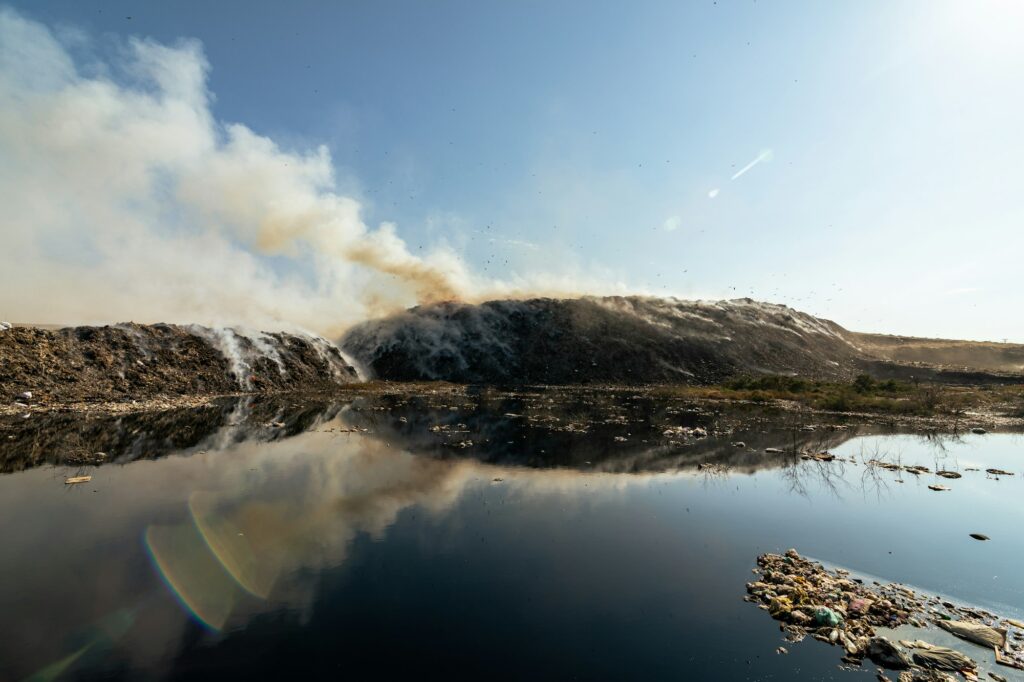Landfill leachate is a liquid that forms when rainwater flows through waste in landfills, picking up harmful substances like heavy metals, ammonia, and chemicals along the way. If not properly treated, it can contaminate nearby water sources and harm the environment or even public health. To prevent this, landfill operators must follow strict environmental regulations to safely manage leachate.
Reverse osmosis (RO) membranes are an important tool in this process, as they can effectively remove many of the contaminants from leachate, helping operators meet discharge standards or support water reuse efforts.
Regulatory Challenges in Landfill Leachate Treatment
Leachate is a complex liquid that contains a mix of harmful pollutants – sort of like a “chemical soup”. Its makeup includes things such as organic substances like ammonia and biodegradable materials, as well as toxic heavy metals like lead, cadmium, and arsenic. It also contains chemicals that are very hard to break down, like PFAS.

Government agencies like the U.S. Environmental Protection Agency (EPA) have strict rules about how much of these pollutants can be released into the environment to protect water sources and ecosystems. For landfill operators, following these rules is getting increasingly complex, and non-compliance can lead to heavy fines or legal trouble.
Landfill leachate often requires a combination of treatment methods due to its complexity, variability, and potentially high pollutant levels. Among these, membrane technology has become a key solution, offering a versatile and effective way to remove contaminants like dissolved salts, heavy metals, organic compounds, and particulates.
How RO Membranes Work
Reverse Osmosis (RO) is a commonly used filtration method that separates pollutants from water. They do this by pushing the leachate through a semi-permeable membrane under pressure. Clean water passes through, while contaminants like salts, organics, and heavy metals are left behind. These membranes can handle both low-strength and high-strength leachates, making them versatile for various landfill operations. With their ability to remove fine particles and complex pollutants, RO systems help produce high-quality water that can be safely discharged or reused.
RO & Regulatory Compliance in Landfill Leachate
RO membranes play a critical role in helping landfill operators meet specific environmental regulations. For example, they are highly effective at removing pollutants like ammonia, nitrates, and heavy metals, all of which have strict discharge limits.
RO systems are also particularly effective at retaining PFAS, which are a group of persistent and harmful chemicals under increasing regulatory scrutiny. By using RO technology, landfills can consistently meet water quality standards, ensuring compliance with local and federal guidelines.
Financial and Environmental Benefits of Using RO
The use of RO membranes provides significant financial advantages for landfill operators. By achieving compliance, operators avoid costly fines and penalties associated with environmental violations. Additionally, RO technology helps prevent contamination of surrounding soils and water sources, reducing the environmental footprint of landfills. In some cases, RO-treated leachate can even be reused, aligning with sustainability goals and reducing the reliance on freshwater resources.
For example, ZwitterCo advanced membrane technologies offer innovative solutions that reduce cleaning frequency and double membrane life – enhancing cost savings. In a European landfill, a two-pass RO system was used to treat leachate, but the high total dissolved solids (TDS) in the feed required seawater RO membranes for the first pass and brackish water RO membranes for a final polish before discharge. Because of high organic levels, the site had to clean the membranes every other day – about 180 times a year – and replace the RO elements every two years. This resulted in high chemical use, labor demands, waste generation, and increased operating costs.
To address these challenges, the landfill replaced their first-pass seawater RO membranes with ZwitterCo’s High Pressure RO elements, which operate at up to 1,200 psi. This allowed the site to maintain high pressure operations while significantly reducing cleaning frequency and extending membrane life. Within two weeks of installation, the site reduced cleaning to once per week and cut cleaning costs by over 70%, achieving a more efficient and cost-effective operation.
Want to read more? Download our free eBook today.
Challenges and Future Directions
While RO membranes are highly effective, they do face challenges like membrane fouling and management of concentrated waste streams. Membrane fouling, caused by the accumulation of organic and inorganic substances on the membrane surface, reduces system performance.
Though fouling has been an ongoing issue with RO membranes, the future of fouling-resistant membranes has arrived. ZwitterCo has developed an advanced RO membrane that uses zwitterionic chemistry to reduce the need for frequent cleaning, extend membrane life, and lower operational costs, making them a breakthrough solution for industries seeking reliable, long-term performance in challenging environments.
In the future, combining RO with other treatment technologies, like advanced oxidation or membrane bioreactors, shows significant potential for improving environmental compliance in landfill leachate treatment. These hybrid approaches not only enhance pollutant removal but also reduce the environmental impact.
With regulations only continuing to grow stricter – especially concerning landfill leachate sites – RO membranes offer a critical solution for treating leachate and ensuring environmental compliance. Their ability to remove a wide array of contaminants, from heavy metals to PFAS, makes them an indispensable tool for landfill operators. Looking forward, adopting advanced membrane technologies will not only ensure compliance but also support broader sustainability goals, including water reuse.


